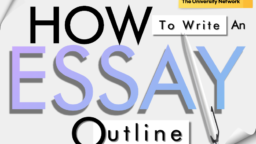How to Write an Essay Outline

For an essay to be compelling, it needs to have a solid structure. That’s why it is so important to write an essay outline before diving into the writing process.
Your college essay outline is the bones of your essay. It helps you portray your ideas in a logical and digestible order. It also serves as a handy tool to keep your essay clean and organized while you’re writing, so you don’t have to spend as much time editing.
So, how do you write an essay outline? What does an essay outline template look like? This guide has tips, along with a template for essay outline examples. Let’s get started.
What to consider before you write an essay outline

Don’t rush through your essay outline just to get it out of the way. A half-hearted outlining and brainstorming the writing process will result in a poorly constructed essay.
Before anything else, you must carefully read and re-read the directions of your essay assignment.
Consider the kind of essay you’re being asked to write. Is it narrative, persuasive, argumentative, or expository? Each kind of essay requires a different approach to outlining and writing. (We explain the differences below.)
From there, ask yourself these questions: “What is the purpose of this essay?” and “What do I want the reader to take away from it?”
Better yet, write down the answers to these questions on a sheet of paper. These are the things that will give you clarity and focus when you sit down to write an essay outline draft.
Organize your thoughts and notes

If you’ve paid attention in class and done your research, you likely have a lot of information in your notes that would be worth including in your essay. But, your notes probably lack a coherent order.
So, before you write an essay outline, you need to take time to organize.
Take a moment to group your notes into categories and then arrange those categories in a way that best supports your thesis.
In essence, the notes and ideas that you consider to be the most important should serve as topic sentences of each body paragraph. And the “supporting details” should be used to reinforce these sentences.
UNC Chapel Hill’s writing center suggests asking yourself the following questions:
- “Do some of my notes naturally cluster together?”
- “How many clusters are there?”
- “Which ideas are more important or general?”
- “Which ones are more like supporting details?”
- “What order should the ideas be in?”
STANDARD ESSAY OUTLINE

As explained above, the way you write an essay outline should vary depending on what type of essay you’ve been assigned to write. But before diving into the distinctions, it’s important to understand the general structure of an effective essay outline.
While different teachers or professors may have different requirements, the typical essay is at least five paragraphs long. There should be an introductory paragraph, three or more body paragraphs, and a paragraph for the conclusion.
Introduction

The introductory paragraph should include a hook, information about the focus of your essay, and your thesis statement.
Right under the “Introduction” section of your essay outline, jot down a potential hook or two. The hook could be an interesting fact, a rhetorical question, or a simple sentence that sets the stage for your essay.
After the hook, you should include points that summarize what you’re going to be writing about in each body paragraph of your essay. This section should give readers a general preview of what they’re going to be reading.
Finally, in the last point under the introduction section of your essay outline, you should write your full thesis statement. And although it isn’t necessary, it may benefit you to also write the thesis statement at the very top of your essay outline. Since the thesis statement is the focal point of your entire essay, it’s always good to have it front and center.
Body

The body of your essay is where you have the most freedom to break down your argument, idea, or explanation.
Structurally, body paragraphs should start with a sentence that states the topic and reinforces your thesis. The four or five sentences that follow should then be used to support this sentence. The supporting sentences should include facts, data, and, in some cases, quotes from credible individuals. If you feel like you don’t have enough data or information to back up this sentence, you may need to go back to your notes or do further research.
And to make sure your essay flows smoothly, you might want to add a transitional sentence at the end of each paragraph.
As far as ordering your body paragraphs, your most compelling point should be made in the first body paragraph. The second best point should be made in the paragraph after that, and so on.
When you write an essay outline, you should include the full sentence that states the topic that you intend to start each body paragraph off with. As far as outlining the supporting ideas, though, all you will need is a few phrases or bullet points to jog your memory when you sit down to write the essay.
Conclusion
Naturally, the conclusion is where you should tie up your essay. You want your reader to look up from reading the essay pondering a new idea, thought, or experience.
Start your conclusion by rephrasing your thesis. Then reiterate some of your main points. Depending on the type of essay you’re writing, you may want to finish the conclusion paragraph with a call to action or a quick summary of the significance of your argument. Need essay outline examples? See the essay outline template below.
| STANDARD ESSAY OUTLINE TEMPLATE Thesis: I. Introduction A. Hook B. Introductory information C. Thesis statement II. Body A. Body paragraph 1 1. Topic sentence: 2. Supporting idea 1: 3. Supporting idea 2: B. Body paragraph 2 1. Topic sentence: 2. Supporting idea 1: 3. Supporting idea 2: C. Body paragraph 3 1. Topic sentence: 2. Supporting idea 1: 3. Supporting idea 2: III. Conclusion A. Restate thesis B. Summarize main points C. Call to action/summarize the significance of your argument |
NARRATIVE ESSAY OUTLINE
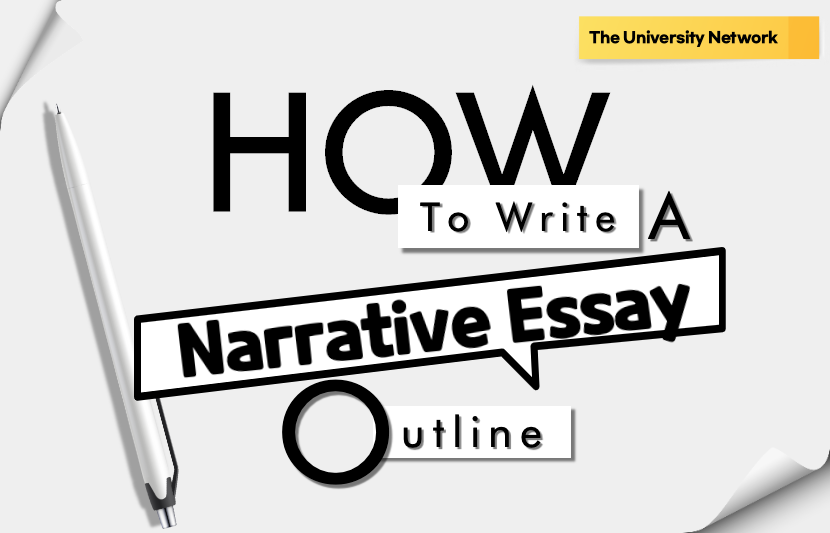
A narrative essay is a piece of writing in which you tell a story from your point of view about a personal experience. While they don’t require extensive research, these essays are not to be underestimated.
Essays that are narrative are very common in nearly every level of education and are often an important piece of the college application and writing process. In fact, all seven of the prompts included in the 2020-21 Common App call for these kinds of essays.
While the prompts for essays that are narrative are often relatively simple, your writing should be thoughtful and engaging.
Take this essay prompt from the 2020-21 Common App, for example:
“Describe a problem you’ve solved or a problem you’d like to solve. It can be an intellectual challenge, a research query, an ethical dilemma — anything of personal importance, no matter the scale. Explain its significance to you and what steps you took or could be taken to identify a solution.”
Yes, those reading your essay do want to know what problem you’ve solved. But, more importantly, they want to gauge how you react to and overcome adversity.
So, take the extra step to make sure your essay serves a purpose. Use description in your writing, and format your essay so that your readers walk away with the feeling that they know you.
Below is a description of what you should include in each section of your essay. The essay outline you create should succinctly summarize each section.
Introduction

Hook
The hook, which should be the first sentence of your essay that is narrative, needs to make the reader want to continue reading. As stated above, the hook could be a fact, a rhetorical question, or an intriguing sentence that sucks the reader in.
Say, for example, you’re writing about a time when you made pasta with your grandmother who lives in Italy. You could start the essay off with a fact about how many pounds of pasta come in and out of the village where she lives.
Stage your essay
After the hook, you want to give the reader a greater sense of the scene. When writing an essay, you don’t have to reveal everything about the place or be too blunt about the setting, but you should at least give a few hints.
Sticking with the pasta example, you could start to explain the smell of the room, the view through the kitchen window, and the feel of the floor underneath your feet. These descriptions would give the reader a sense of your surroundings, the climate, and the age of the house. When writing an essay that is narrative, you want to show the reader, not tell them.
Thesis statement
Typically, the purpose of the thesis statement is to provide a digestible summary of the main point or claim you’re making in your essay. Using the same pasta example, you could draft a compelling sentence about how making pasta at your grandmother’s house in Italy inspired your passion for the art of cooking.
The reason thesis statements are so often placed in the introductory paragraph is so the reader can develop an early understanding of the purpose of your essay. However, because essays that are narrative are meant to be a personal story, you don’t always have to make the thesis statement so evident.
While writing an essay that is narrative, you could use the last sentence of the introduction simply as a way to naturally progress into the body of the essay. If you do this, though, you need to make sure that your theme is still evident. Although chronological order can make for an intriguing narrative essay, you don’t want your theme to be buried too deep.
Body

In the body of your essay is where you dive into the full story of your experience. Each body paragraph should support your thesis.
Let’s, again, use the pasta example. If your thesis statement describes the theme that making pasta at your grandmother’s house in Italy inspired your passion for the art of cooking, you need to create body paragraphs that support that statement.
In the first paragraph or two, you could describe how cooking drew you in. You could explain how you felt when you smelled the pasta or what was going through your mind as you watched your grandmother roll homemade noodles. Remember, show don’t tell. Use adjectives and verbs to paint a picture.
You could also describe how cooking makes you feel. Is it therapeutic? Is it a fun challenge? Is it nostalgic? Let the reader view your emotions.
In the last paragraph of the body, wrap up the story. After you left Italy and came back to the United States, did you immediately start cooking?
If your essay is in chronological order, make sure the story comes to a close naturally. Don’t rush it just because you’ve run out of space. If there is a word limit on your essay, check back through the previous paragraphs to see if there is anything that you can edit out. Reassess from there.
Conclusion
In the conclusion of the essay, you could explain what cooking has taught and how it has helped you in other areas of your life. Maybe you’ve increased your patience. Maybe you’ve learned how to multitask. There’s a chance cooking has helped you develop a way to manage your emotions.
These skills can all be related back to other things in your life. For example, if you’re writing a narrative essay for a college application, maybe point out how the skills you’ve developed from cooking translate to the subject you’re interested in majoring in. Explaining how cooking has helped you improve is a great way to naturally express your love for it, and, in turn, reinforce your thesis.
PERSUASIVE ESSAY OUTLINE
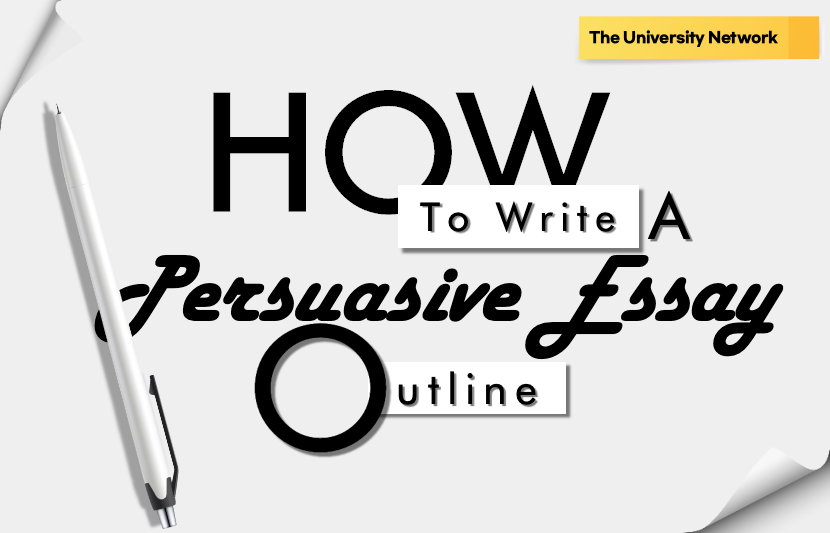
A persuasive essay is a piece of writing that you use to convince the reader to agree with your point of view.
In order to be compelling, these essays should be full of verified facts and quotes from experts, which requires a great deal of research. The goal of an essay that is persuasive, though, is not to simply regurgitate facts. Because you are trying to persuade someone, you have to mix in a bit of emotion.
In terms of outlining, these essays are more simple than narrative essays. They tend to follow a formula.
Below is a description of what you should include in each section of this kind of essay. When you write an essay outline, you should succinctly summarize each section.
Introduction

Hook
Again, the hook should be a fact, a rhetorical question, or an intriguing sentence that sucks the reader in and makes them want to continue reading.
Let’s say, for example, you’re writing an essay that is persuasive to convince your high school to establish a wrestling program. You could start the essay with a fact highlighting the impressive number of high schools in the district that already have a wrestling program.
Introduce your arguments
In the typical five-paragraph essay that is persuasive, you should have three arguments that support your thesis statement. Each argument should be made in its own paragraph, and each of those paragraphs should start off with a sentence that states the topic and that summarizes the argument. During the writing process, write each of these sentences down in this section of the essay outline.
Thesis statement
This is where you should succinctly explain what you want. If what you want is your school to start a wrestling program, state that.
You want to be very clear and sometimes even blunt with these essays. Unlike narrative essays, the point of this kind of essay is to persuade, not to show off descriptive writing skills or portray your personality.
Body

In the body of an essay that is persuasive is where you get to convince your reader. Just like if you were arguing with a family member at the dinner table, this is your opportunity to lay out your points and make a compelling argument.
Each paragraph should start with a sentence that states the topic, and the sentences that follow should be full of facts, and sometimes quotes, that reinforce this sentence.
The first paragraph is where you want to make your strongest argument. Sticking with the wrestling example, you could make the argument that there is a demand for the sport.
This is a good argument to start with because it is likely the biggest concern shared by the administrators at your high school. In the supporting sentences, you could provide the number of students at your school who have already agreed to join. Additionally, you can provide attendance numbers from meets held at schools in the district that already have a team.
In the second paragraph, you could make the argument that it can help student land scholarships at universities. Of course, you’ll want to back this up with some statistics. And if the statistics you find aren’t that convincing, use an example instead.
If you find that only 1 percent of high school wrestlers get college scholarships, for example, tell a brief success story of a student who wouldn’t have been able to go to college had they not wrestled. Make the point that this could happen at your school.
In the third paragraph, address the administration’s fears about students’ safety by explaining that there is little risk of injury in wrestling. Compare it to other sports your school offers, like football, to make your point. Of course, you do need statistics to back this up.
Conclusion
- Restate your thesis
Make your point abundantly clear by restating your thesis. Because the reader has read your arguments at this point, you can add a little more detail than at the beginning.
- Summarize the main points
As you did with your thesis statement, you’ll want to restate your sentences that state the topic. This will drive the point home and cement your arguments in the reader’s brain.
- Write a call to action
End your essay with a call to action. In this example, you’ll be asking your administrators to create a wrestling team.
ARGUMENTATIVE ESSAY OUTLINE
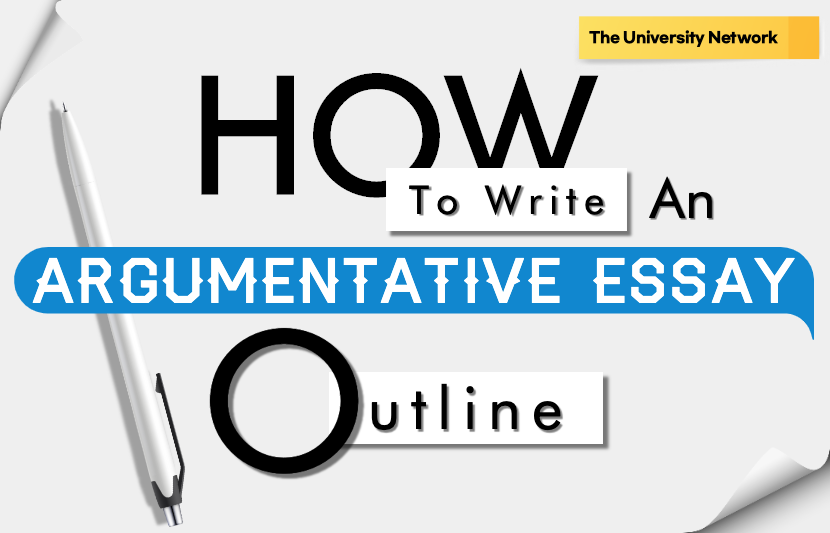
Argumentative essays are often confused with persuasive essays. But, there are subtle differences that you should be aware of.
While the goal of an essay that is persuasive is to persuade a reader to side with your point of view, the goal of an argumentative essay is simply to convince the reader that your position is valid.
While writing this kind of essay, try to stick to facts. Don’t get wrapped up in emotion or description.
In terms of an argumentative essay outline, these kinds of essays also follow a formula.
Below is a description an argumentative essay outline and what you should include in each section of your essay. The argumentative essay outline you create should succinctly summarize each section.
Introduction

Hook
Like all of the other types of essays in this article, the essay should start with a hook, which should be a fact, a rhetorical question, or an intriguing sentence that sucks the reader in and makes them want to continue reading.
Let’s say, for example, the topic is: “Do Division 1 athletes deserve to be paid?” If your position is yes, you could start with a fact about how much money the University of Alabama’s football team brings in each year, for example.
Before moving on, it is worthwhile to note that your goal in this essay is to simply make the argument that they deserve to be paid. You aren’t necessarily trying to persuade the NCAA to pay athletes.
List your main points
Right after the hook, you should introduce your main points. In the body of your essay is where you will provide detail and further explain these points. Here, though, each point should be introduced in no more than one or two sentences.
Thesis statement
Here is where you should succinctly state your argument. Make sure the reader knows what side you’re taking. It is worth noting, though, that you shouldn’t let your emotions seep into your thesis statement or anywhere in your essay. Argumentative essays are supposed to be built upon facts.
Body

In the body of your essay is where you should break it all down. All the statements you made in the introduction should be further explained here. Like you would when writing a persuasive essay, you should present your strongest point in the first paragraph. Each paragraph should start with a topic sentence and be followed by supporting sentences.
Sticking with the paying Division 1 athletes example, in the first paragraph, you could further explain the point that schools often profit off of their athletes, and athletes see nothing in return. Of course, you would need to back this up with statistics.
In the second paragraph, explain to your reader that student athletes don’t have time to work because the sport they play is essentially a full-time job. For this, you would need statistics about how many hours per week athletes spend practicing.
After you’ve finished making your points, many teachers and professors will ask that you add another paragraph that mentions the counter arguments and provides your evidence against them.
For example, you could mention the common argument that many Division 1 athletes are essentially being paid because they’re getting scholarships to play sports. You could then use statistics to back up the position that there are many costs of college other than tuition, and that if athletes don’t have time to get a job because they are at practice, they can’t afford food.
Conclusion
Restate your thesis
Restate your thesis in a way that brings your essay to a natural conclusion. You want the reader to think about your position as something that deserves attention.
Summarize main points
After you restate your conclusion, you want to summarize your main points. In the writing process, don’t simply rewrite the sentences that state the topic from your body paragraphs. Instead, subtly remind the reader why your points are important to consider.
Remind the reader why your argument is worthwhile
Again, argumentative essays are all about validating a position or side to an argument. So, in the final sentence or two of your essay, you want to leave a lasting impression. You could, for example, end with another related fact that reminds the reader why your argument is worthwhile. Write something like “X percent of Division 1 athletes live below the poverty line, while the institutions they play for rake in Y amount of money each year.”
EXPOSITORY ESSAY OUTLINE
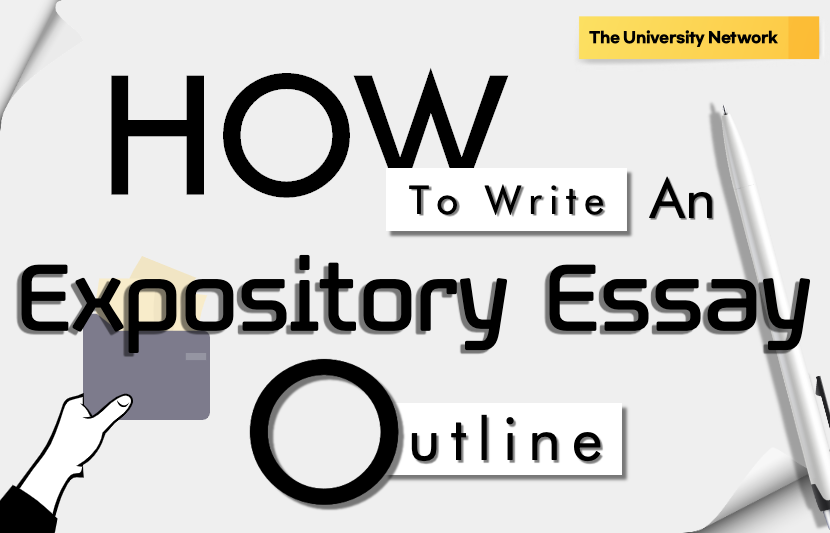
The expository essay is a type of essay that requires you to investigate an idea, piece of literature, or moment in history, evaluate evidence, and expound upon it. The goal is not to make an original argument, but instead to explain a topic in a straightforward and digestible way. Writing should always be in the third person.
In the classroom, you’ll most often be asked to write expository essays on literature, social issues, or historic events. The expository essay is also the type of essay on the SAT.
Expository is essentially a catch-all term for many different types of essays, including the compare and contrast essay, the cause and effect essay, and the descriptive essay.
Expository essays test your critical analysis skills. And, depending on the subject, expository essays may require a great deal of research. Working on the essay outline in the writing process, however, is pretty simple, as there is a general formula.
Below is a description of what you should include in each section of your expository essay. The essay outline you create should succinctly summarize each section.
Introduction

Hook
The expository essay must also start with a hook. It needs to be catchy and relate closely to the topic.
Let’s say you’ve been tasked to write an expository essay analyzing how J.K. Rowling uses character development techniques to make the characters in the Harry Potter series so compelling. You could start with a rhetorical question pointing out how ironic it is that Hagrid — a bearded giant who plays with spiders and dragons — is such a lovable character.
Introduce your points
You should have points to back up your overall topic. Each point should be explained in its own paragraph, and each of those paragraphs should start with a topic sentence that summarizes the point. Introduce each point in this section of the introduction.
Thesis statement:
The thesis statement of an expository essay is where you express the conclusion you’ve come to after conducting research on a subject or reading literature. Your goal is to inform your reader, not persuade them. Think of yourself as a reporter. Your thesis statement in your expository essay is, essentially, the same as a lead in a news story.
Using the Harry Potter example, your thesis statement could fall along the lines of: “J.K Rowling’s usage of unique adjectives and her desire to emphasize intellectual qualities over physical attributes makes her characters compelling.”
Body
In the body paragraphs of your expository essay is where you get to fully explain what you’ve gathered to your readers. Like you would with arguments in a persuasive essay, you want to start off with your strongest point.
Building upon the Harry Potter example, the first paragraph should dive into Rowling’s word usage. Your topic sentence, for example, should explain that Rowling uses unique adjectives to describe her characters. Then, in the following sentences, you should use examples from the text to back that up.
Then, in the second paragraph, you should restate and provide backing for your point that Rowling emphasizes intellectual qualities over physical attributes.
Expository essays typically have 3-5 body paragraphs. So, include a new paragraph for each point you have.
Conclusion

Restate your thesis
As you would when writing a persuasive essay, you should make the first sentence of your conclusion a restatement of your thesis.
Summarize the main points
You also want to summarize your main points in the conclusion, but you should do it in an original way. You never want to introduce new information in this section.
The final sentence
The final sentence you use should vary depending on the type of expository essay you’re writing. However, you should always put time and effort into sculpting your final sentence. It is your last opportunity to leave an impression of your point of view on the readers.
In summary
Although it can feel a bit like busywork, to write an essay outline is an essential component of writing a good, compelling essay. Without an essay outline, your writing runs the risk of lacking structure. So don’t underestimate the importance of your essay outline, and certainty do not skip over it. Take time before the writing process to work on a college essay outline, and it will save you the frustration of having to extensively edit and revise after you’re finished.


